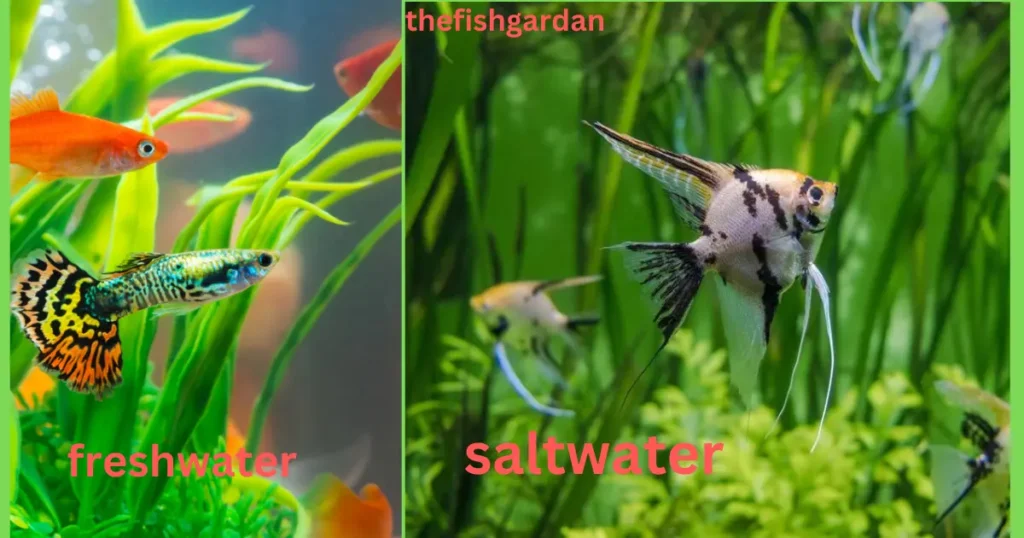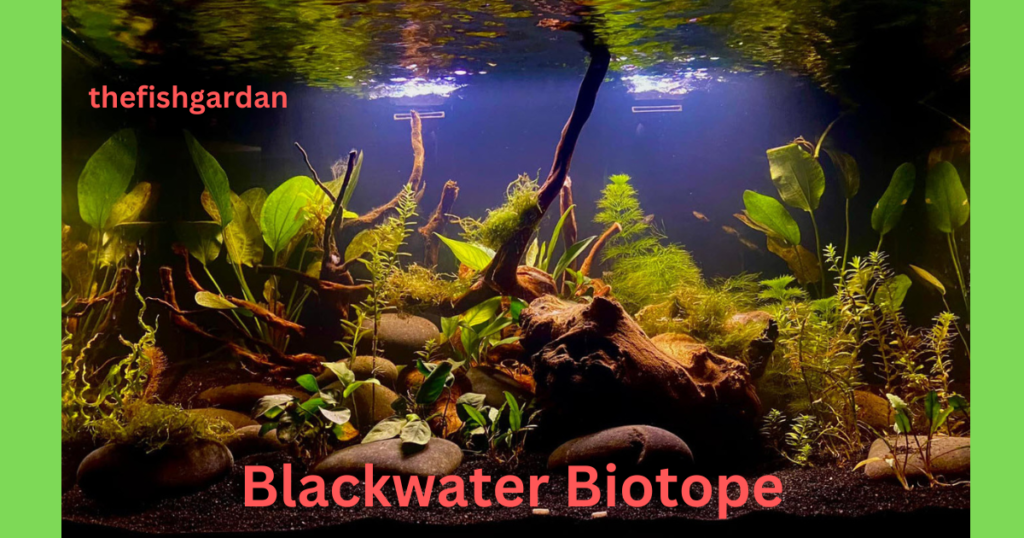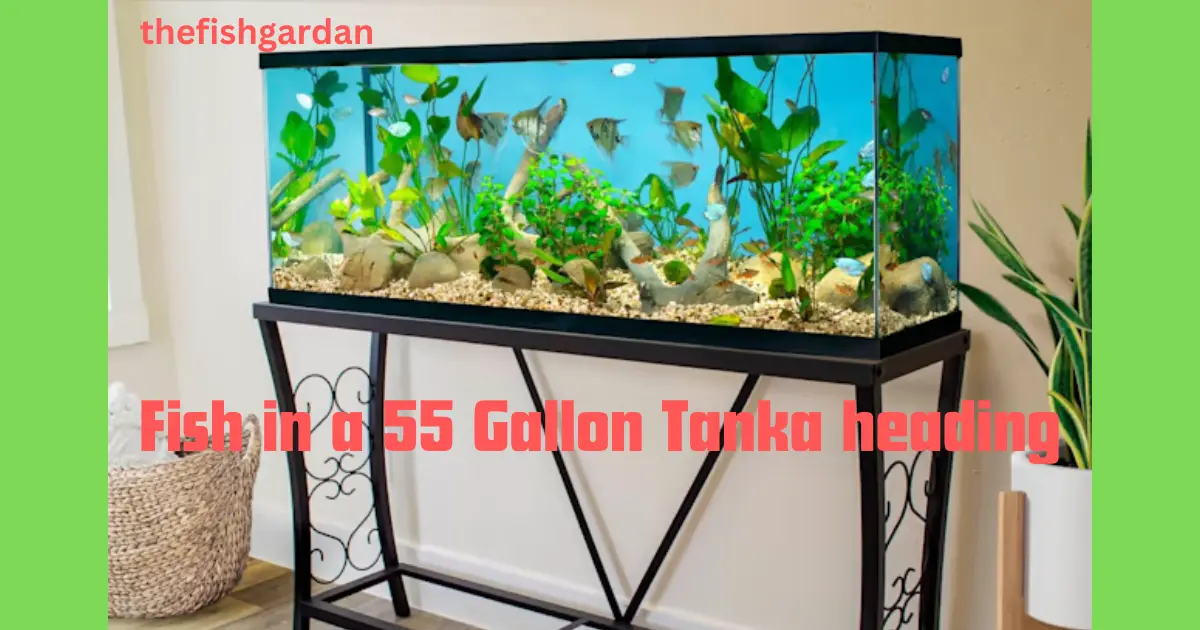A 55 gallon aquarium can make for an exciting and visually appealing addition to any home or office. With proper planning and research, a 55 gallon tank can be an excellent environment for a variety of freshwater and saltwater fish. However, overcrowding a tank can cause major issues with water quality, aggression, stress and disease. So a key question for any new or experienced aquarist is: how many fish can safely be kept in a standard 55 gallon tank?
What are the Dimensions of a 55 Gallon Tank?
Before determining fish capacity, it’s important to understand the physical dimensions of a 55 gallon aquarium. A standard 55 gallon tank has the following dimensions:
- Length: 48 inches
- Width: 13 inches
- Height: 21 inches
This provides a total water volume of approximately 55 gallons or 208 liters. Tanks of this size are a very popular choice for fish hobbyists as they allow space for most community fish, are relatively affordable, and can fit in most homes. The large surface area allows for ample oxygen exchange.
How Much Surface Area Does a 55 Gallon Tank Provide?
- Length x Width = 48″ x 13″ = 624 square inches of floor space
- Height x Width x 2 = 21″ x 13″ x 2 = 546 square inches of side surface area
- Length x Height x 2 = 48″ x 21″ x 2 = 2016 square inches of back/front surface area
- Total surface area = approximately 3186 square inches
This abundant surface area is key for allowing sufficient oxygenation and gas exchange in the tank.
What are Good Water Parameters for a 55 Gallon Aquarium?
Before adding fish, it’s crucial to establish and maintain proper water conditions in a 55 gallon tank. Here are some general water quality guidelines:
- Temperature between 72-82°F depending on fish species
- pH between 6.5-7.5
- Ammonia and nitrites at 0 ppm
- Nitrates less than 20 ppm
- Water hardness between 5-12 dGH
- Aquarium salt at 0.5-1 tbsp per 5 gallons for freshwater or 34-36 ppt for saltwater
Perform regular partial water changes, test water parameters frequently, and use chemical filter media like activated carbon to help maintain ideal conditions. Proper water parameters reduce fish stress and prevent disease.
What is the Best Filtration for a 55 Gallon Aquarium?
Filtration is vital in a 55 gallon community tank to prevent ammonia and nitrite spikes. The filter or filters should have a total gph (gallons per hour) rating of 5-10 times the water volume. For a 55 gallon tank, this equals 275-550 gph of filtration.
Some top filter options include:
- Canister filter rated for 100+ gallon tanks
- Two large hang-on-back power filters rated for 50-75 gallons each
- A canister combined with a hang-on-back or internal power filter
Adequate flow, media capacity and redundancy are key for biological filtration in a heavily stocked community tank. Add chemical media like activated carbon monthly to help control odors, discoloration and contaminants.
What Fish Can Live in a 55 Gallon Tank?
Now onto stocking. Many species of fish can thrive in a tank of this size, but research compatibility, adult sizes and temperaments before selecting fish. Here are some top options:

Freshwater Fish
- Small tetras (ember, cardinal, neon, rummynose)
- Medium tetras (black skirt, serpae)
- Large tetras (bleeding heart, Congo)
- Barbs (cherry, tiger, odessa)
- Danios (zebra, pearl)
- Rasboras (harlequin, lambchop)
- Corydoras catfish (bronze, sterbai, peppered)
- Plecos (clown, bristlenose, rubberlip)
- Gouramis (pearl, honey)
- Mollies, platies, swordtails
- African cichlids (yellow lab, acei, kenyi)
- Angelfish
- Discus
- Rainbowfish (boesmani, Australian)
- Guppies
Saltwater Fish
- Clownfish
- Damselfish (chromis, azure)
- Cardinalfish
- Basslets
- Blennies
- Gobies
- Jawfish
- Dartfish
- Firefish
- Rabbitfish
- Pseudochromis
- Royal gramma
- Sixline wrasse
- Clowngobies
Mix and match moderate numbers of the above species for a dynamically colored and active 55 gallon community. Perform research to ensure compatibility, then stock conservatively starting with small numbers over several weeks.
What is the Best Way to Stock a 55 Gallon Tank?
When stocking a new 55 gallon tank, follow these guidelines for success:
- Quarantine new fish. Use a separate 10-20 gallon tank to observe new fish for 2-4 weeks before adding to main tank. This prevents introducing disease.
- Add stable rock and driftwood before fish to establish biological filtration and allow time to monitor for pH shifts.
- Start with hardy fish first. Add tolerant species like danios, platies, mollies initially to help complete the nitrogen cycle.
- Introduce less aggressive fish before territorial ones like cichlids or gouramis.
- Add fish gradually over 4-8 weeks. Build up gradually to the desired stocking level. Avoid large batches at once.
- Monitor water parameters and perform partial water changes frequently when starting out. Test for ammonia, nitrites, nitrates.
- Feed sparingly at first, then slowly increase to normal feeding levels. Excess food can foul water rapidly.
- Ensure adequate filtration and circulation for the planned bioload. Upgrade if needed.
With this conservative approach, a 55 gallon tank can safely be stocked to moderate community levels.
What is Overstocking and Why is it Harmful?
Now let’s discuss the risks of overstocking a 55 gallon tank. Overstocking refers to adding an excess number of fish that the tank cannot support. Problems include:
- Spikes in ammonia and nitrites from overfeeding and fish waste. Highly toxic.
- Increased aggression and territoriality due to lack of space.
- Greater risk of disease transmission from high bioloads.
- Low oxygen levels from overcrowding and excess organic waste.
- Stunted growth from competition for resources and poor water quality.
- Emaciation from inability to secure adequate food.
- High fish mortality from the above stressors.
Overstocking often reflects a lack of research and failure to account for adult sizes. While understocking is recommended, overstocking is extremely harmful long-term.
What is the Maximum Number of Fish for a 55 Gallon Tank?
So what is the maximum number of fish that a 55 gallon aquarium can safely support? There are a few guidelines:
- General rule is 1 inch of adult fish per 1-2 gallons of water. A conservative stocking density allows 1 inch per 2 gallons.
- For a 55 gallon tank, this equals 27-55 inches of total fish length.
- Another common guideline is 1 inch of fish per 20-30 square inches of surface area. A 55 gallon tank has ~3186 square inches of surface area. This equals 106-159 inches of fish.
- For medium sized community fish around 2 inches long, this equates to 13-27 fish in a 55 gallon tank.
- For larger cichlids that can reach 6 inches, aim for only 4-9 fish. Massively overfiltered tanks can sometimes accommodate more fish.
- Ultimately, pay attention to fish behavior and water parameters. Aggression, poor growth or water quality issues demand reducing stocking levels.
In summary, a conservative fully stocked 55 gallon tank would have 13-27 medium sized community fish or 4-9 large cichlids. Only exceed these general limits with caution and careful monitoring.
Tank Size Calculator for Fish Stocking
To take the guesswork out of stocking, here is a handy 55 gallon tank size calculator for estimating fish capacity:<style type=”text/css”> .tg {border-collapse:collapse;border-spacing:0;} .tg td{border-color:black;border-style:solid;border-width:1px;font-family:Arial, sans-serif;font-size:14px; overflow:hidden;padding:10px 5px;word-break:normal;} .tg th{border-color:black;border-style:solid;border-width:
Use this to estimate stocking levels based on the adult size of chosen fish species. Stay on the conservative side of these limits and reduce levels if issues emerge.
Ideal Tank Mates for a 55 Gallon Aquarium
To create a thriving community tank, select compatible fish that inhabit similar water parameters. Here are some ideal tank mates for a 55 gallon aquarium:
- Tetras + Corydoras: Schools of ember tetras, cardinal tetras or rummynose tetras combined with a group of corydoras catfish make classic tankmates. Provide plenty of plants and driftwood.
- Rainbowfish + Gouramis: Boesmani rainbowfish, praecox rainbowfish and pearl gouramis have similar environments. Floating plants are appreciated.
- Mollies + Swordtails + Platies: These lively livebearers add lots of movement and color. Combine with bottom-dwelling plecos or loaches. Provide plenty of vegetation.
- African Cichlids: A 55 can house dwarf mbuna like yellow labs, rusties and acei. Overfilter and stock conservatively. Pay attention to aggression.
- Community + Clean up Crew: Combine schools of small tetras and rasboras with plecos, cories and shrimps for clean up. Heavily plant the tank.
Research before mixing fish from drastically different regions or with different temperaments. Overfiltering helps create more stocking flexibility.
What Maintenance is Needed for a 55 Gallon Aquarium?
To keep fish healthy, a 55 gallon tank requires regular maintenance. Key tasks include:
- Weekly 25-50% partial water changes using a gravel vacuum to remove waste. Match temperature and chemistry.
- Monthly filter cleaning in old tank water to retain beneficial bacteria. Rinse foam/floss media when clogged.
- Testing water parameters 1-2 times monthly for ammonia, nitrites, nitrates, pH. Address any issues.
- Cleaning glass with aquarium scrapers or algae pads to maintain clear viewing.
- Pruning plants to remove dead leaves and control rapid growth.
- Removing uneaten food daily to reduce waste buildup.
- Checking equipment function like filters, pumps and lights. Replace if needed.
- Monitoring fish health to watch for signs of disease or aggression requiring removal.
With proper maintenance, a 55 gallon aquarium can provide a healthy and visually stunning environment long-term for a wide variety of fish species and aquatic life.
55 Gallon Tank Aquascaping Ideas
A well-designed aquascape can turn a 55 gallon tank into a thriving naturalistic ecosystem. Here are some inspiring ideas:
Natural Planted Tank
Create the feel of an aquatic nature preserve with plants like:
- Tall background plants: Vallisneria, jungle val, anubias on driftwood
- Midground plants: Java fern, anubias nana, cryptocorynes
- Foreground plants: Dwarf hairgrass, dwarf sagittaria, pygmy chain sword
- Floating plants: Frogbit, red root floaters, duckweed
Add leaf litter, branches, rocks and caves. Stock with small schooling fish like tetras and natural colored strains.
Driftwood & Rock Hardscape
Focus on creating a striking hardscape layout with materials like:
- Spiderwood, manzanita or Malaysian driftwood
- Seiryu stone, dragon stone or lava rock formations
- Smaller rocks, pebbles and substrate to create slopes
Accent with low plants like mosses, anubias and ferns attached to the hardscape. Stock with schooling fish or bottom dwellers.
African Cichlid Rockscape
Make a rocky habitat with lace rock stacked to form caves and overhangs.
Plant tough species like anubias, java fern and vallisneria that can withstand cichlid digging.
Stock with African Rift Lake cichlids like yellow labs, acei and zebras. Provide plenty of hideouts.
Blackwater Biotope
Simulate an Amazon blackwater river with:
- Driftwood emerging from the water
- Dim lighting, tannins from botanicals
- Leaf litter covering the bottom
- Floating plants dimming the light
Stock with tetras, angelfish, corydoras and plecos. Use blackwater extract for tea-colored water.

Conclusion
In closing, stocking a 55 gallon fish tank requires carefully balancing fish size, numbers, behaviors and water parameters to create a healthy community. Conservatively select fish suited for a 55 gallon environment, then gradually build up populations while monitoring conditions. Limit total fish lengths to 27-55 inches and provide robust filtration. Follow the one inch per gallon rule as a starting point, then adjust based on actual tank dynamics. Overstocking leads to poor health, stress and water quality issues. With prudent planning
With prudent planning and proper fish selection, a 55 gallon aquarium can thrive with a moderate community of 13-27 small schooling fish or 4-9 larger cichlids. Perform regular partial water changes, filtration maintenance and testing to keep water clean. Feed a varied diet in moderation.
Carefully observe fish interactions and behavior, adjusting stocking levels downward at any sign of aggression or stress. Implement an appealing aquascape with plants, hardscapes and hiding spots. A well-run 55 gallon tank makes an impressive centerpiece display while providing a healthy habitat for a variety of aquatic species. With research and responsible stocking, both fish and aquarist can enjoy the vibrant underwater world of a 55 gallon community aquarium.
FAQ About 55 Gallon Aquariums
What stand should I use for a 55 gallon tank?
Use an aquarium stand rated for 50-75 gallons. A 55 gallon tank weighs over 600 lbs fully filled, so stability is crucial. Cabinet-style stands also conceal equipment.
What heater is best for a 55 gallon aquarium?
Use a 100-150 watt submersible heater. Match heater capacity to the tank volume. Brands like Eheim Jager and Aqueon Pro can maintain stable temperatures. Use two lower watt heaters for redundancy.
Are live plants required in a 55 gallon community tank?
Live aquarium plants are extremely helpful for eating nutrients, absorbing fish waste and providing visual barriers. Include at least moderate planting, ideally with fast growing stem plants. Plants help maintain water quality.
What fish can live with angelfish in a 55 gallon tank?
Good angelfish tank mates include small tetras, rasboras, cory cats, dwarf gouramis and swordtails. Avoid fin nippers like barbs and large aggressive species that may prey on angelfish.
Can you put saltwater fish in a 55 gallon tank?
Yes, a 55 can house small saltwater species like clownfish, gobies and blennies. Stick to fish under 4-5 inches. Focus on fish only systems with live rock and quality protein skimming. Perform frequent partial water changes.
